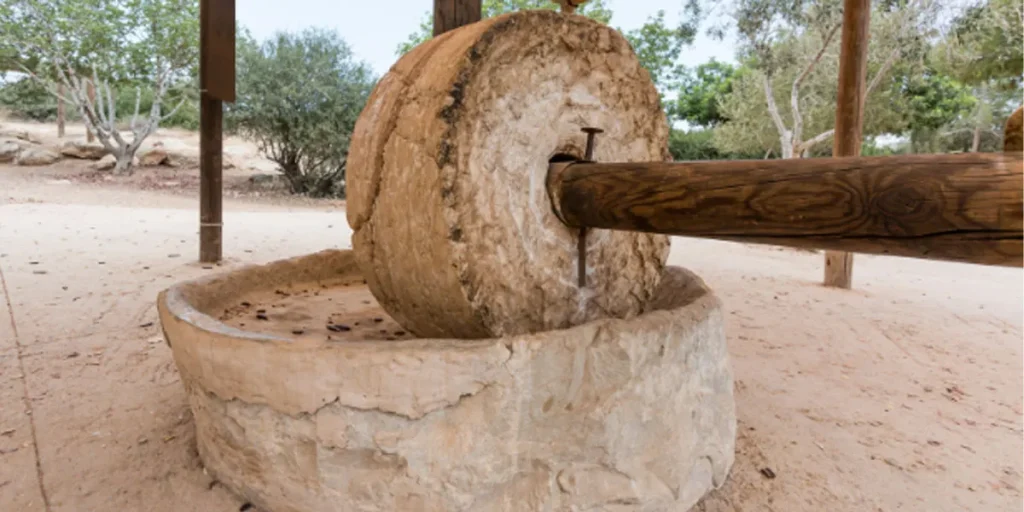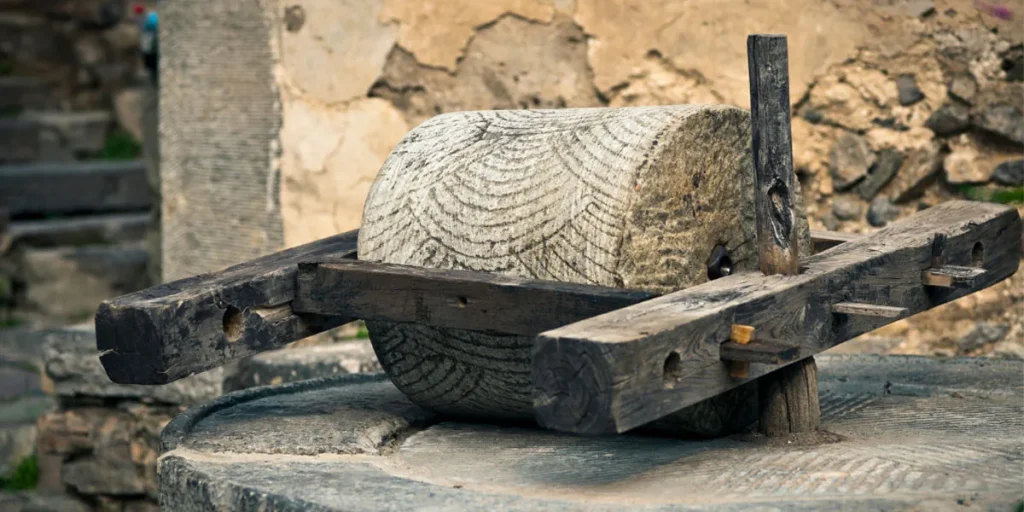A typical millstone can weigh between 1,400 to 2,600 lbs (635 to 1,180 kg). The exact weight varies depending on the stone’s size and material.
Millstones have been essential to agricultural societies for centuries, grinding grain into flour or meal. Historically, these stones came in various sizes, influencing their weight.
Large millstones, used in commercial milling, can easily surpass a ton. Conversely, smaller ones, often seen in less industrial contexts, weigh considerably less.
The material—typically burrstone or granite—also affects the weight, with denser stones tipping the scales at the higher end.
Today, millstones not only serve a functional purpose in niche milling operations but also stand as relics of bygone craftsmanship, making them coveted items for gardens and historical displays.
Their heft is a testament to their durability and the strenuous labor once required to operate them.
Role Of Millstones In History
The millstone plays a vital role in human history. These heavy stones ground grains into flour for food. For thousands of years, millstones have symbolized sustenance and food production.
Ancient Milling Techniques
Ancient cultures crafted millstones from a variety of natural resources. Early millstones, known as quern-stones, were hand-operated. These simple tools laid the groundwork for milling development.
- Egyptians used saddle querns around 6000 B.C.
- The Greeks introduced rotary millstones around 450 B.C.
- Romans employed animal power to drive larger millstones.
Evolution And Significance
Over time, the design of millstones evolved. Their significance grew as communities depended on them more. Millstones became larger and more effective with technological advances.
| Period | Development | Impact |
|---|---|---|
| Middle Ages | Windmills and watermills | Larger millstones operated by natural forces |
| Industrial Revolution | Steam power | Milling on a massive scale |
| Present Day | Electricity and automation | Efficient production and finer grinds |
In every stage, millstones have been central to progress. Their weight symbolizes the heavy burden of manual labor shifting to mechanized systems.
Materials And Craftsmanship

Understanding the weight of a millstone begins with the materials used and the skill involved in its creation.
Let’s explore the different types of stones and the craftsmanship needed to shape them into efficient millstones.
Types Of Stones Used
- Granite: Known for its hardness and longevity.
- French Burr: Valued for its sharpness and complexity.
- Sandstone: Offers a rough surface that is ideal for grinding.
Each type of stone influences the millstone’s weight. A granite millstone can weigh between 600 to 1,500 pounds, depending on its size.
French Burr stones, often smaller, still tip the scales at around 500 pounds. Sandstone varies greatly but can be just as heavy as granite, due to its density and size required for milling.
Art Of Shaping Millstones
Crafting millstones is an art passed down through generations. Expert hands shape each stone with precision, ensuring a balance that promotes efficient milling. Here’s an outline of the process:
- Selection of the raw stone based on its intended use.
- Cutting and shaping the stone into a rough disk.
- Carving grooves and chiseling to perfect the grinding surfaces.
- Finishing with balancing for smooth operation.
The expertise of the millwright impacts the final weight of the millstone. Balanced stones translate to less wear and more efficient grain processing.
Careful craftsmanship may reduce excess weight without sacrificing function, creating a millstone that could last for decades.
Sizing Up The Millstone
Millstones are huge, heavy stones used to grind grains. Their weight has fascinated many throughout history.
Standard Dimensions Through Ages
Different times had different millstone sizes. Here are typical sizes:
- Roman times: Small, around 45 cm in diameter.
- Medieval Europe: Larger, up to 90 cm.
- 19th century: Could reach 1.3 meters or more.
These stones are usually round. Thickness can vary from 8 to 15 cm.
Measuring The Mass
Determining weight is important. Estimations based on size are:
| Diameter | Thickness | Estimated Weight |
|---|---|---|
| 45 cm | 10 cm | ~75 kg |
| 90 cm | 15 cm | ~300 kg |
| 130 cm | 20 cm | ~1000 kg |
Materials also affect weight: sandstone is lighter, granite is heavier. Knowing this helps transport and install these ancient tools.
The Weighty Influence On Grinding

Millstones play a crucial role in grinding grains into flour. Their weight directly impacts how finely and effectively grains are ground.
This heavy duo grinds grains through sheer force, transforming whole ingredients into powders fit for baking and cooking.
Impact Of Size And Weight
Grinding surfaces need substantial weight to properly function. Heavier millstones exert more pressure, resulting in finer flours.
Most millstones weigh between 100 to 800 kilos—a true testament to their grinding might.
- Smaller stones weigh less but can still grind effectively.
- Larger stones often exceed half a ton, ensuring a finer grind.
| Size | Weight Range (kg) |
|---|---|
| Small | 100 – 200 |
| Medium | 300 – 500 |
| Large | 600 – 800 |
Optimizing Milling Efficiency
Choosing the right millstone weight is key to optimizing milling efficiency. It’s essential to balance weight with rotational speed to maximize productivity.
- Optimum weight ensures thorough grinding.
- Correct speed prevents overheating.
- Balanced weight and speed boost mill life.
Fine-tuned setups yield the best flour consistency, with less waste and downtime. Mills seek the ideal weight-speed combination for top efficiency.
Modern-day Millstones
Millstones have evolved over centuries. From ancient times to now, their weight and use have changed.
These stones are now part of modern machinery. We see them in small mills and as historical displays.
Comparison With Historical Counterparts
Old millstones were very heavy. They could weigh up to several tons.
Today’s stones are smaller and lighter.
- Average historical millstone: 2,000 lbs (900 kg)
- Modern millstone: 100 to 1,000 lbs (45 to 450 kg)
Contemporary Uses And Adaptations
Nowadays, millstones are versatile. They grind grains in artisanal mills.
People also use them for decoration. Some even serve as garden features.
| Use | Description | Weight Range |
|---|---|---|
| Grinding grains | For making flour | 100-600 lbs |
| Garden paving | As stepping stones | 100-300 lbs |
| Decoration | In homes and museums | 50-200 lbs |
Preservation And Display
Spanning centuries, millstones remain symbols of our rich cultural heritage.
Preserving these stone giants is crucial for storytelling.
Displaying them bridges past and present, teaching us about historical milling techniques.
Millstones As Historical Artifacts
Often weighing several hundred pounds, millstones echo the feats of early technology.
Each stone tells a unique story, shaped by the hands that crafted it.
Museums and parks often display them, paying tribute to their crucial role in agriculture.
Exhibiting Millstone Heritage
Displaying millstones involves both creativity and respect for their history.
Outdoor exhibits allow them to stand majestic, while indoor settings can involve detailed informational plaques.
Interactivity can enhance the experience, like turning cranks to demonstrate milling.
| Location | Display Type | Visitor Experience |
|---|---|---|
| Outdoor Parks | Natural Setting | Immersive |
| Historical Museums | Educational Plaques | Informative |
| Heritage Sites | Interactive Displays | Hands-On |
It’s essential to strike a balance between protecting and sharing these artifacts.
Careful consideration ensures millstones continue to educate and inspire.
FAQ About the Weight of a Millstone
What Is The Average Weight Of A Millstone?
Millstones, crucial for grinding grain, typically range from 1,200 to 2,300 pounds.
Their weight varies based on material, size, and craftsmanship.
How Are Millstones Sized And Measured?
Millstone size is determined by diameter and thickness. Traditional ones span from 30 to 84 inches.
They’re measured using calipers and measuring tapes.
Can The Weight Of A Millstone Vary?
Yes, millstone weight can differ significantly. Variations result from material density, size, and historical era.
Granite and limestone commonly influence weight differences.
What Materials Are Millstones Made From?
Millstones are crafted predominantly from durable, gritty stones like granite, basalt, or limestone.
Material choice affects the stone’s weight and grinding capabilities.
Conclusion
Understanding millstone weights is crucial for historians and mill enthusiasts alike. Whether for educational purposes or practical applications, the information provided offers clarity.
Remember, sizes vary, but typically, a millstone can weigh between 1,300 to 2,600 pounds. For exact figures, always reference the stone’s specifications or consult an expert.
Adopting this knowledge, you can appreciate the millstone’s historical and functional significance with the correct weight in mind.
